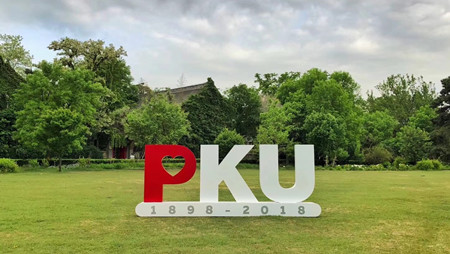[120th Anniversary Special] The Historic Shape of Campus: Jing Courtyard
May 03, 2018
Peking Universty, May 3, 2018:
This article is part of a series of pieces exploring the architecture of Peking University’s campus in honor of the University’s 120th anniversary.
Peking University is renowned for its historic architecture and picturesque campus. In addition to the West Gate and Weiming Lake, the Jing courtyard, consisting of the six small, inner Jing Yuan buildings arranged three to a side and separated by a wide grassy field, is an oft-photographed and celebrated spot on campus. Behind the purple wisteria flowers and beautiful peaked roofs, the buildings also are testaments to Peking University’s history.
The majority of the Jing Yuan buildings were originally built for Yenching University which occupied much of the present-day campus of Peking University. Yenching University, established by missionaries, was formed with the consolidation of four existing Christian schools between 1915 – 1920. To provide a new, dedicated space for the university, the administration purchased Qing dynasty gardens and worked to transform the landscape into a scenic campus.
American architect Henry Murphy designed the Jing Yuan buildings, along with much of the rest of the Yenching University campus, in a traditional Chinese style. This was a deliberate choice and reflects similar architectural work by Murphy at other universities in China. Murphy’s goal was to meld traditional style and modern amenities as well as creating harmony between the landscape and the architecture of the university. The construction of campus buildings of Yenching University, including the original four buildings of the Jing courtyard, was completed in 1926.
The Jing Yuan courtyard buildings were built during the first wave of campus construction and were meant to serve as dormitories for the female students at the university. The initial four buildings that made up the dormitory complex were named Jing Zhai敬斋, Ye Zhai业斋, Le Zhai 乐斋, and Qun Zhai 群斋. Together, the four characters spell out the phrase 敬业乐群, meaning "devotion to work and happiness in community."
When Peking University moved to the campus previously occupied by Yenching University in 1952, two additional buildings were added to the Jing courtyards to make the modern complex of six buildings. Although students and visitors might not differentiate between the more recent construction of buildings 3 and 6, compared to the original buildings of 1, 2, 4 and 5, they were nonetheless not part of the original set of dormitories.
Today, the students who stop to admire the courtyards and their flowers may not know that the buildings were built by an American or originally used as dormitories. As students continue to use these buildings, however, they are retracing the steps of previous generations of scholars who paused during breaks in their studies to appreciate the beauty of this campus.
Reported by: Erin Dunne
Edited by: Xu Liangdi
" This article would not have been possible without the contributions from the PKU Relic Fans club which provided information used in their upcoming campus guide which is currently being translated to English. "

